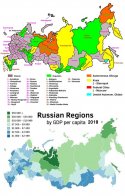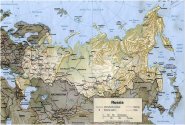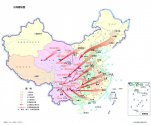if a land war breaks out bw NATO and Russia in Eastern Europe and China is concerned about Russians collapse or usage of nukes, then the logical move is to attack US forces in westpac and shifting its attention away rather than moving its forces to Europe.
This is nonsense.
Mackinder:
"Who rules the World Island commands the world"
If Russia becomes unstable then
nothing in WestPac will matter. In terms of strategic balance between US and China WestPac is a
relative pivot point but Russia is the
absolute pivot point. WestPac is fundamental only because Russia is not available as a theater. But the failed invasion of Ukraine opened up that possibility in the mid-to-long term. Once that is available Japan, Korea, Taiwan and the rest will become unimportant islands on the sidelines of the core strategic contest.
Russia is also the absolute priority for China because of geography. Russia is to China what Canada is to the US except that it protects China from three sides, and not just one. While northern flank is obvious note that Russia also secures Central Asia for China and denies access to land infrastructure on Pacific coast forcing the US to rely on 1&2IC and Korea.

Due to Russia's nuclear arsenal a full-scale conflict between Russia and NATO remains extremely unlikely however sub-threshold or "hybrid" warfare is already being prepared and NATO has geographical advantage.
Russia has structural and political vulnerability as a federation created on top of territory acquired through imperial conquest. Russia's authoritarian regime exists to secure the state in its current form against external influence that could undermine political control in sparsely populated but energy-rich regions in the north and east.

Without access to resources from those rich peripheries Russia can't sustain itself economically. Those regions have very low population:
- Nenets AOkr. - 50k(70% Rus)
- Komi Rep - 850k (65% Rus)
- Yamalo Nenets AOkr. - 500k (60% Rus)
- Khanty-Mansi AOkr. - 1 500k (70% Rus)
- Krasnoyarsk Kr. - 2900k (90% Rus) of which ~1m in Krasnoyarsk
- Sakha/Yakutia Rep. - 1 000k (30% Rus)
- Magadan Obl - 150k (80% Rus)
- Kamchatka Kr. - 300k (90% Rus)
- Chukotka AOkr. - 50k (55% Rus)
- Sakhalin Obl. - 500k (90% Rus)
A total of ~7,8m people in areas responsible for Russia's (~150m) economic growth. The areas with the core of Russia's population don't matter in economic terms because even Moscow and St.Petersburg regions are indirectly dependent on resource-rich regions. GRP is misleading.
This is Russia's main road and rail network. No it's not a joke.

All of Russia's periphery that is open to NATO sea and air power projection is devoid of infrastructure that could support defensive action.
At the same time all of these areas are on average ~2000-3000km from China and are accessible primarily by air, especially in rapid deployment.
In such a scenario stabilization of potential breakaway regions is the primary concern. Time of reaction will be
decisive and heavy airlift capability and aerial refueling will be of infinitely more value than VLO bombers.
The US
will trade current WestPac territory for Siberia because capturing those regions gives it leverage over European Russia and foothold in Asia that opens northern and eastern flank to China.
In such scenario China will have to secure all of Siberia all the way to Urals to either maintain favourable regime in Moscow or prepare Beijing-friendly separatist entities in case of total collapse of Russian Federation.
The Russian scenario is also very dangerous to China for another reason - it is the only scenario where US and EU can cooperate with equal interest in the outcome. It would effectively be the continuation of the failed intervention in the Russian civil war.
While the EU will do as little as possible in any WestPac scenario it
will join the US if Russia is on the table so that is something that definitely must be under consideration in Washington. And furthermore there is a point in the future at which it becomes also a beneficial scenario for China for many reasons that I won't get into here.
The dismantling of Russian Federation is in China's strategic long-term interest. The preservation of Russian Federation is in China's strategic short-term interest only because it can't afford to realize its long-term interest at current moment.
You can argue about YY-20 vs H-20, but the reality is YY-20 is already in service. So the need there is to ramp up production rather than developing the aircraft
Increasing production consumes financial resources. The main problem with H-20 will not be design maturation but
production capacity. My comment from 29/12/22 on B-21 vs H-20:
Well indeed. I can envisage a situation where Japan gets its own nukes (to the extent it doesn't already have them) and asks US forces to leave. However, that doesn't solve the problem of H20 having to cross neutral territory to attack CONUS. We can assume Japan will be either on the US side...
www.sinodefenceforum.com
It does little good for China to have a working design if it can't maintain sufficiently high production rate from the start. That is also part of R&D in this case because of the unique nature of the airframe. H-20 is J-20 quality at Y-20 scale. It's not something that China is currently capable of mass-producing.
The flexibility of H-20 and what they can do makes attack missions an order of magnitude easier to plan and carry out than H-6.
It has some advantages but volume is still decisive. What works in WestPac fantasy scenarios on SDF doesn't work in others in real world.
H-20 is not B-21. B-21 plays a greater role as a C4 node due to distance. The US has to overcome distance to
enter theater. China is already here. VLO and other capabilities come as addition to range + volume. H-20 in the near term will be primarily a payload delivery system and in that it can be replaced by H-6 in multiple scenarios particularly over land.
Russia is just one possible scenario. Also: India-Pakistan, Central Asia and Iran, Myanmar etc. The paradox of H-20 is that until it arrives in greater numbers it is at a disadvantage vs more numerous and cheaper systems like H-6 + YY-20 with the exception of a few specific scenarios that happen to be in SDF's field of view to the exception of everything else.




